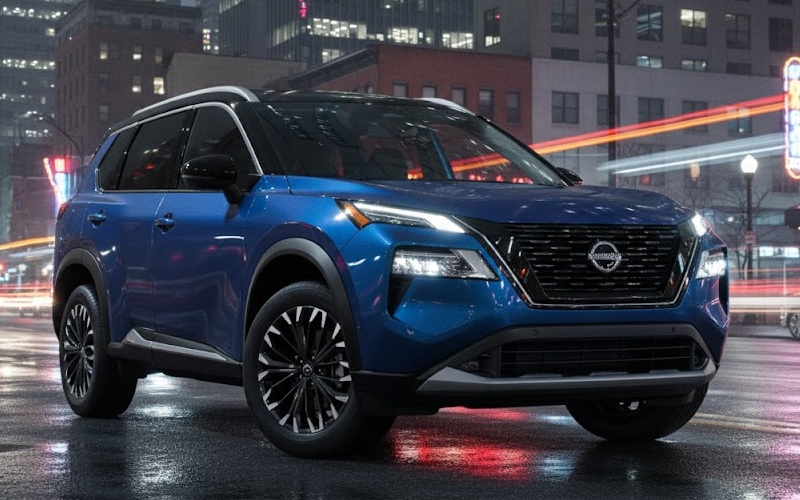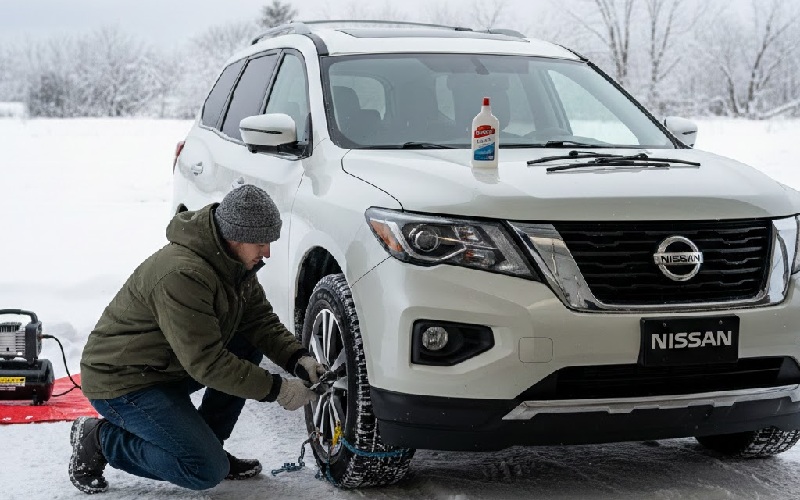How to Start Your Nissan Rogue with Key: Step-by-Step Guide
The Nissan Rogue stands as one of the most popular compact SUVs on the market, combining versatility, comfort, and technology in a stylish package. While newer models feature push-button ignition systems, many Nissan Rogue owners still use traditional keys or key fobs to access and start their vehicles. Understanding the proper techniques for starting your […]
The Nissan Rogue stands as one of the most popular compact SUVs on the market, combining versatility, comfort, and technology in a stylish package. While newer models feature push-button ignition systems, many Nissan Rogue owners still use traditional keys or key fobs to access and start their vehicles. Understanding the proper techniques for starting your Nissan Rogue with a key ensures you’ll never be left stranded, even when technology fails or batteries die. Let’s explore the various methods to start your Nissan Rogue, from standard key operation to emergency procedures when your key fob battery depletes.

Your Nissan Rogue Key Options
The first step to properly starting your Nissan Rogue involves understanding which type of key system your vehicle utilizes. Nissan Rogue models typically come with one of three key types: a traditional mechanical key, a standard key fob with remote functions but requiring manual insertion, or an Intelligent Key with push-button start capability.
Traditional mechanical keys are the simplest option, featuring no electronic components. These basic keys work through direct mechanical interaction with the ignition cylinder. Standard key fobs combine a mechanical key with remote functions like door locking/unlocking and panic buttons, but still require insertion into the ignition. The Intelligent Key system represents the most advanced option, allowing passive entry and push-button ignition while keeping the fob in your pocket or bag.
Identifying your key type is essential for following the correct starting procedure. Check your owner’s manual or examine your key – traditional keys have no buttons, standard key fobs have buttons with a visible key blade, and Intelligent Keys feature buttons with a removable emergency mechanical key hidden inside.
The Standard Key Start Process
For Nissan Rogue models equipped with a traditional key or standard key fob, the starting process follows conventional steps. First, ensure your vehicle is in Park (P) position if equipped with automatic transmission, or Neutral if manual. Apply firm pressure to the brake pedal with your right foot and maintain this position throughout the starting process.
Insert the key into the ignition cylinder located on the right side of the steering column. The key should slide in smoothly without resistance. If you encounter difficulty, gently wiggle the steering wheel while inserting the key, as the steering lock may be engaged.
Once inserted, turn the key clockwise to the “ON” position, which activates the vehicle’s electrical systems. Dashboard lights will illuminate during this self-check phase. After a brief moment, continue turning the key fully clockwise to the “START” position, which engages the starter motor. Hold in this position until the engine starts, but never for more than 5-7 seconds to prevent starter damage.
Release the key immediately after the engine starts. The key will automatically return to the “ON” position, allowing normal vehicle operation. If the engine fails to start on the first attempt, return the key to the “OFF” position, wait 10 seconds to allow the starter motor to cool, and try again.
Intelligent Key System Operation
Many newer Nissan Rogue models feature the Intelligent Key system, which still includes a physical key option for emergency situations. Under normal circumstances, starting the vehicle with the Intelligent Key system requires the fob to be inside the vehicle, typically within 1 metre of the push-button ignition switch.
To start your Nissan Rogue with the Intelligent Key, first ensure the vehicle is in Park (P) and firmly press the brake pedal. With the brake pedal depressed, press the push-button ignition switch once to activate the vehicle’s electrical systems, then press it again to start the engine. The engine should start immediately, and the green READY indicator light will illuminate on the instrument panel.
In situations where the Intelligent Key’s battery is depleted, Nissan has engineered a backup method to start the vehicle. Remove the emergency mechanical key from the fob by sliding the small release lever on the back and pulling the key out. This mechanical key allows access to the vehicle if the remote entry function fails.
Once inside the vehicle, you’ll need to touch the Intelligent Key directly to the push-button ignition switch while simultaneously pressing the brake pedal and the button itself. This direct contact method allows the immobilizer chip in the key to communicate with the vehicle’s security system even when the fob’s battery is dead. After touching the fob to the button for approximately 2 seconds, you can press the ignition button normally to start the engine.
Emergency Start Procedures for Key Fob Battery Failure
When your Nissan Rogue key fob battery weakens or dies completely, the vehicle includes several backup methods to ensure you’re not stranded. For models with standard key fobs, the mechanical key portion continues to function in the ignition cylinder even when the remote features fail.
For Intelligent Key systems, Nissan implements a sophisticated backup system. If your Intelligent Key battery dies, the dashboard will display a “Key Battery Low” warning. Despite the low battery, the passive entry system can still operate through the key’s passive RFID chip, which doesn’t require battery power.
If the key fob is completely dead, press the brake pedal and touch the Nissan logo side of the key fob directly to the push-button ignition switch. The vehicle’s systems will detect the key’s identity chip through direct contact. While maintaining this contact, press the ignition button to start the engine.
For situations where even this method fails, Nissan Rogue models include an emergency override procedure. Locate the small cover on the steering column near the ignition button. Remove this cover to reveal an emergency key slot. Insert the mechanical emergency key from inside your fob into this slot and turn it while pressing the brake pedal. This mechanical override bypasses the electronic systems entirely.
Common Key Start Issues
Even with proper technique, you may occasionally encounter difficulty starting your Nissan Rogue. Several common issues can prevent normal key operation, but most have simple solutions.
If your key won’t turn in the ignition, the steering wheel lock is likely engaged. This safety feature prevents steering when the key is removed. To release it, insert the key and gently turn it while simultaneously moving the steering wheel slightly left and right. This movement releases tension on the locking pin, allowing the key to turn.
For situations where the key turns but the engine doesn’t crank, check that the transmission is fully in Park position. Nissan vehicles include a safety interlock that prevents starting in any other position. Also, verify that the brake pedal is firmly pressed before turning the key or pressing the ignition button.
If your Intelligent Key system fails to recognize the key fob, first check for interference. Common sources include smartphones, laptops, and other electronic devices that may interfere with the key’s signal. Move these devices away from your key and try again. Also, ensure you’re using the correct key, as multiple programmed keys for the same vehicle will have identical appearances.
Battery issues represent another common starting problem. If your vehicle’s battery is weak, you may notice dim dashboard lights or slow cranking. In this case, jump-starting the vehicle may be necessary before normal key operation will resume. Connect jumper cables to a donor vehicle’s battery, wait several minutes, then attempt to start your Rogue using normal procedures.
Proper Key Maintenance and Care
Maintaining your Nissan Rogue keys in optimal condition ensures reliable operation and prevents inconvenient failures. For traditional keys, regularly inspect for wear, bending, or damage to the key teeth, as these can prevent proper interaction with the ignition cylinder.
For key fobs, battery replacement represents the most common maintenance need. Most Nissan Rogue key fobs use CR2025 or CR2032 lithium coin batteries, which typically last 2-3 years depending on usage. When your dashboard displays the “Key Battery Low” warning or when remote functions become intermittent, it’s time for replacement.
To replace your key fob battery, locate the small notch on the edge of the fob case. Insert a small flathead screwdriver or coin into this notch and gently twist to separate the case halves. Remove the old battery, noting its orientation, and insert a new battery in the same position. Snap the case halves back together and test all functions.
Keep your keys away from extreme temperatures, which can damage electronic components or warp physical keys. Avoid attaching heavy keychains that can place stress on the ignition cylinder when the key is inserted. Additionally, keep spare keys in a safe, accessible location – ideally both at home and with a trusted friend or family member who could bring it to you in an emergency.
Professional Key Support Options
When DIY solutions fail to resolve key issues, professional assistance becomes necessary. Nissan dealership service departments offer comprehensive key support, including cutting and programming new keys, diagnosing electronic key system failures, and repairing damaged ignition cylinders.
For mechanical key issues, locksmiths with automotive expertise can often provide more affordable alternatives to dealership service. Many can cut replacement keys on-site using your key code, which can be found on your vehicle’s documentation or by providing proof of ownership.
Emergency roadside assistance services often include lockout support for situations where you’ve lost access to your vehicle. These professionals can help you regain entry to your vehicle, though they typically cannot address more complex issues like key programming or ignition repair.
For the most comprehensive protection, consider subscribing to the Nissan roadside assistance program, which includes specific support for key and lockout issues. This service provides peace of mind that professional help is available whenever key problems arise.
5 Nissan Rogue Key Start Facts
- The Nissan Rogue key fob contains a built-in mechanical key that slides out from the bottom, providing emergency access when the fob’s battery dies.
- Newer Nissan Rogue models feature an intelligent key system that can detect the key’s presence within 1 metre of the vehicle without requiring the driver to remove it from their pocket.
- The Nissan Rogue key fob includes an emergency immobilizer chip that authenticates with the vehicle’s computer system, preventing theft even if a mechanical key is copied.
- When a Nissan Rogue key fob battery weakens, the vehicle will display a “Key Battery Low” warning on the instrument panel approximately 30 days before complete battery failure.
- The Nissan Rogue intelligent key system operates on a radio frequency of 315 MHz, which is why keeping it near strong electromagnetic sources can temporarily interfere with its function.
Questions and Answers About the Nissan Rogue
How do I start my Nissan Rogue if the key fob battery is dead?
- If your Intelligent Key fob battery dies, you can still start your vehicle by pressing the logo side of the key fob directly against the push-button ignition switch while simultaneously pressing the brake pedal. The vehicle will detect the embedded chip in the key through direct contact. Alternatively, remove the emergency mechanical key from inside the fob and use it to access the vehicle, then follow the direct-contact method to start the engine.
Why won’t my key turn in the Nissan Rogue ignition?
- The most common reason a key won’t turn in the ignition is an engaged steering wheel lock. This safety feature activates when the steering wheel is moved after removing the key. To release it, insert the key and gently turn it while simultaneously moving the steering wheel slightly left and right until you feel the lock disengage. Other causes include worn keys, damaged ignition cylinders, or the transmission not fully in Park position.
How often should I replace my Nissan Rogue key fob battery?
- Key fob batteries typically last 2-3 years with normal use. Replace the battery when you notice reduced range for remote functions, intermittent operation, or when your dashboard displays the “Key Battery Low” warning message. Most key fobs use CR2025 or CR2032 lithium coin batteries, which are readily available at electronics stores, pharmacies, and automotive shops.
Can I start my Nissan Rogue if I lost all my keys?
- If you’ve lost all keys, you cannot start the vehicle without obtaining a new properly programmed key. Contact an authorized dealership with proof of ownership (vehicle registration, insurance, and identification). They can create and program a new key using your vehicle’s identification number (VIN). This process typically requires towing the vehicle to the dealership if it cannot be started.
Does the Nissan Rogue have a hidden key slot for emergencies?
- Yes, many models with push-button ignition systems include a hidden emergency key slot. This backup system is behind a small cover on the steering column near the ignition button. If normal starting methods fail, remove the cover to access this slot, then insert the mechanical emergency key (found inside your Intelligent Key fob) and turn it while pressing the brake pedal to start the engine.
*Disclaimer: Content contained in this post is for informational purposes only and may include features and options from US or international models. Please contact the dealership for more information or to confirm vehicle, feature availability.*


